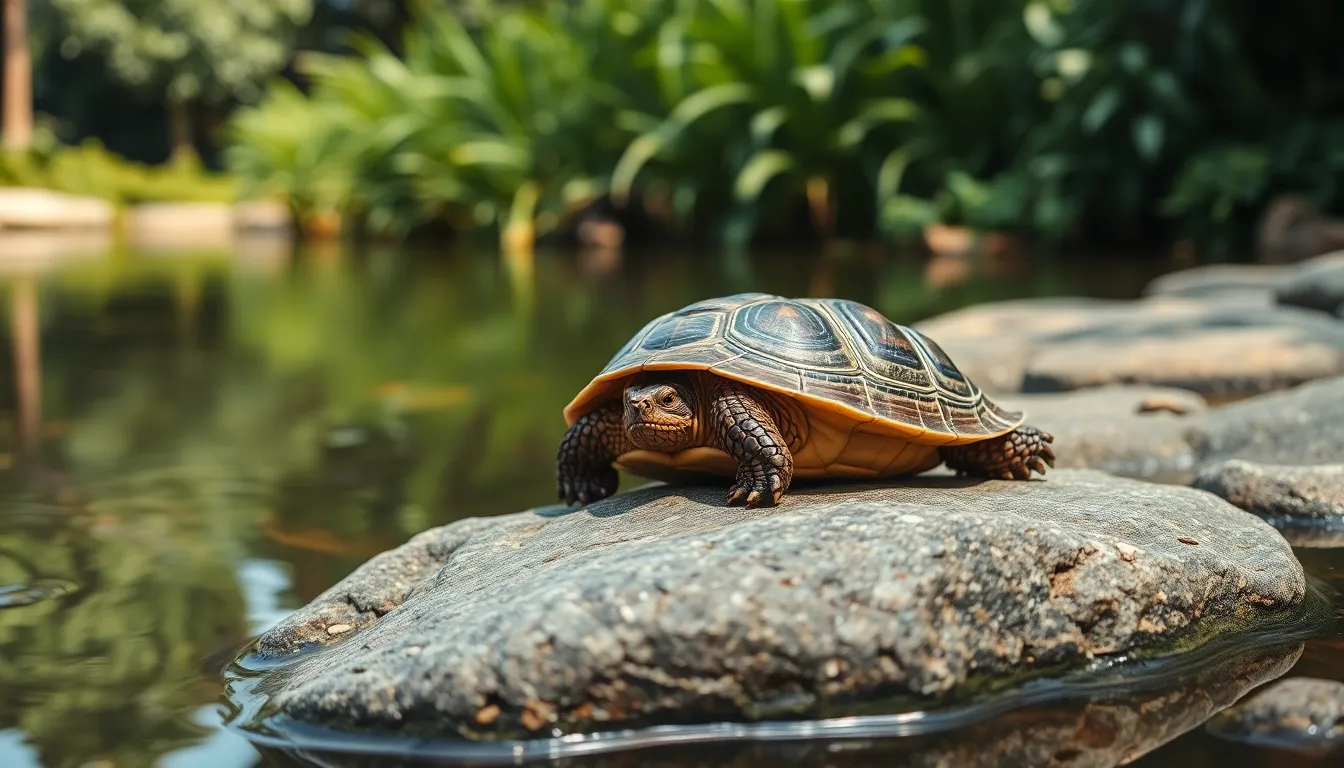Turtles have long puzzled both casual observers and science enthusiasts alike. With their hard shells and slow-moving ways, they seem to straddle the line between land and water. So, are they amphibians or reptiles? Spoiler alert: they’re not the confused cousins of frogs and salamanders.
In this article, we’ll dive into the fascinating world of turtles and uncover what truly defines them. From their unique adaptations to their ancient lineage, these shelled wonders have a story worth telling. Get ready to shed some light on this age-old question and impress your friends at the next trivia night. Who knew learning about turtles could be so entertaining?
Table of Contents
ToggleOverview of Turtles
Turtles represent a diverse group of reptiles known for their distinct shells. They inhabit various environments, including oceans, rivers, and forests. With over 300 species, turtles exhibit a range of sizes, colors, and behaviors. Their lifespan is impressive, often exceeding 50 years, with some species living over 100 years.
The body structure of turtles is unique. A bony shell consists of two parts: the carapace, or upper shell, and the plastron, or lower shell. This shell provides protection against predators. Besides their shells, turtles possess strong limbs adapted for swimming or burrowing. Aquatic species often have webbed feet for efficient movement in water.
Turtles possess remarkable adaptations to survive in their environments. Aquatic species hold their breath for up to 30 minutes when submerged. They also utilize temperature regulation to maintain body heat, crucial for their survival. Many turtles are herbivores, while others have omnivorous diets. Diet influences habitat preferences and activity levels across different species.
Reproductive behaviors vary widely among turtles. Most lay eggs on land, choosing sandy or soft soil for nesting. Some species exhibit temperature-dependent sex determination, where the incubation temperature influences the gender of hatchlings. Hatchlings emerge after several weeks and instinctively head towards the water.
Overall, turtles play vital roles in their ecosystems. They help maintain aquatic plant populations through grazing and contribute to nutrient cycling in their habitats. Understanding turtles enhances appreciation for these ancient reptiles and their ecological significance.
Characteristics of Reptiles

Reptiles exhibit a number of distinctive traits that set them apart from other animal groups, including amphibians.
Skin and Scales
Reptiles feature dry skin covered in scales made of keratin, a protein that provides protection and minimizes water loss. Scales come in various shapes and sizes, offering adaptability to different environments. This adaptation plays a crucial role in terrestrial survival, ensuring reptiles retain moisture in arid habitats. Unlike amphibians, which generally possess moist skin, reptiles thrive in diverse ecosystems thanks to their tough, scaly exterior. Some reptiles can also shed their scales, aiding in growth and regeneration.
Reproductive Methods
Reptiles mainly reproduce through egg-laying, but some species do give live birth. Eggs are often hard-shelled, offering protection to developing embryos in terrestrial environments. Various species exhibit internal fertilization, ensuring successful reproduction in different habitats. In contrast to amphibians, reptiles typically do not have aquatic larvae; instead, hatchlings resemble miniature adults. Some reptiles, such as certain turtles, demonstrate temperature-dependent sex determination, which influences their offspring’s gender based on incubation temperatures. This unique reproductive strategy reflects adaptability to changing environmental conditions.
Characteristics of Amphibians
Amphibians exhibit several distinct characteristics that separate them from reptiles. Their skin remains moist, playing a crucial role in respiration, as they absorb oxygen through it. Often, this skin contains mucus glands, which help maintain moisture. Amphibians primarily breathe using lungs, but they also rely on cutaneous respiration. This dual method of respiration makes them unique and well-suited to both aquatic and terrestrial habitats.
Moist Skin and Respiration
Moist skin serves a significant purpose for amphibians. The skin not only helps in respiration but also in preventing excessive water loss. Anaerobic pathways also play a role when oxygen levels become low. When submerged, amphibians can stay underwater by absorbing oxygen directly through their skin. Healthy skin of amphibians reflects their habitat, which often includes moist environments like ponds and forests.
Life Cycle Stages
Life cycles of amphibians typically include distinct stages. Most begin as eggs laid in water, developing into aquatic larvae known as tadpoles. Over time, these tadpoles undergo metamorphosis, transitioning into adult forms that can thrive on land. Generally, adult amphibians possess lungs, unlike their larval counterparts. This unique life cycle allows them to adapt to changing environments and utilize diverse ecological niches.
The Classification of Turtles
Turtles belong to the class Reptilia, highlighting their classification as reptiles rather than amphibians. They fall under the order Testudines, which includes all turtle species. Families within this order encompass diverse groups, such as Cheloniidae for sea turtles and Emydidae for pond turtles. Turtles possess a unique anatomical structure, specifically a hard shell, distinguishing them from both reptiles and amphibians. Unlike amphibians, turtles retain their characteristics through all life stages, avoiding the metamorphosis typical of amphibians.
Scientific Classification
Turtles classify scientifically under Reptilia in the phylum Chordata. Within this classification, they further divide into two main groups: Pleurodira and Cryptodira. Pleurodira includes turtles that bend their necks sideways to retract into shells, while Cryptodira features those that tuck their heads straight back. Approximately 360 species exist, exhibiting various forms and colors. Each species adapts uniquely to its environment, influencing classification based on specific traits. The evolutionary lineage dates back more than 200 million years, marking turtles as ancient reptiles in the evolutionary history.
Differences in Habitats
Distinct habitats characterize different turtle species, influencing their adaptations and behaviors. Aquatic turtles, such as sea turtles, thrive in oceans and large lakes, often featuring webbed feet for swimming. Many terrestrial turtles prefer dry environments, including deserts and grasslands, using strong limbs for digging and burrowing. Freshwater turtles inhabit rivers, ponds, and marshes, taking advantage of both land and water. Some turtles even exhibit specialized adaptations, such as the softshell turtle, which can live in sandy riverbanks and breathe through their skin. These diverse habitats enable turtles to occupy varied ecological niches, contributing significantly to ecosystem balance.
Common Misconceptions
Many people mistakenly categorize turtles as amphibians due to their aquatic habitats. Turtles occupy a variety of ecosystems, from oceans to freshwater bodies, reinforcing their classification as reptiles. Unlike amphibians, turtles possess dry skin covered with scales, which helps minimize water loss.
Some individuals also confuse turtles with frogs or salamanders. This confusion arises because turtles can be found in similar environments. Despite these shared habitats, turtles belong to the class Reptilia, while amphibians are a distinct class with different physiological traits.
Another misconception involves the way turtles reproduce. People often believe turtles undergo stages similar to frogs, but turtles primarily lay eggs on land. The temperature of the incubation environment influences the gender of hatchlings in several turtle species, a fascinating fact that sets them apart from amphibians.
Turtles display unique adaptations like their bony shells, which provide protection against predators. While amphibians rely on moist skin for respiration, turtles breathe air with lungs. This distinction enhances their survival in terrestrial and aquatic habitats.
Individuals sometimes overlook the potential lifespan of turtles, leading to underestimations of their longevity. Certain species can live beyond 100 years, a characteristic not commonly associated with amphibians. Recognizing these differences clarifies the unique position of turtles within the animal kingdom.
Turtles are fascinating creatures that embody the characteristics of reptiles. Their unique adaptations and long lifespans set them apart from amphibians. With over 300 species thriving in diverse habitats, turtles play essential roles in their ecosystems. Understanding their classification as reptiles helps clarify common misconceptions and highlights their remarkable evolutionary journey. As they continue to capture the interest of researchers and enthusiasts alike, turtles remind us of the intricate connections within the animal kingdom.








